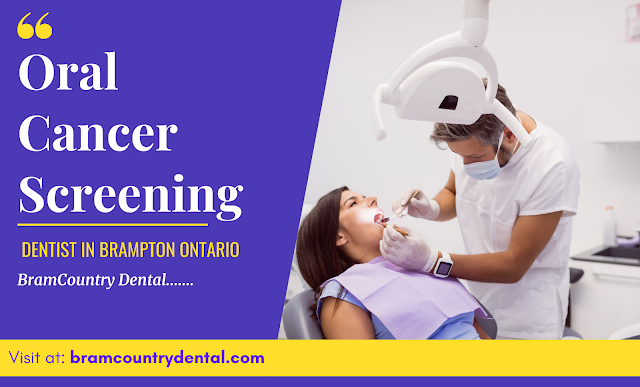Oral cancer, a biological process that
begins with associates well, innovate that the signs of cancer. This makes oral
examinations performed by the dentist of paramount importance.
Oral cancers may be of varied
microscopic anatomy sorts like a tumor, glandular cancer, and skin cancer. The
most common type of oral cancer is malignant squamous cell carcinoma.
This type of oral cancer usually
originates in the lips and oral tissues.
According to a Dentist in
Brampton, there are various areas in the oral and maxillofacial cavity
where oral cancers commonly develop, including:
- Lips
- Mouth
- Language
- Salivary glands
- Oropharyngeal region (throat)
- Gums
- Face
In This Article
- Reasons for an oral cancer exam
- Signs of Oral Cancer by Dentist in
Brampton
- From infection to cancer
- Oral cancer screening exam by
Dentist in Brampton
Reasons for an oral cancer exam
It is important to note that nearly 75
percent of oral cancers are linked to modifiable behaviors such as smoking, and
heavy drinking. Your dentist can provide you with literature and advice on
changing your lifestyle and quitting smoking.
When oral cancer is diagnosed at an early stage, treatment is usually very effective. Any noticeable
abnormalities of the tongue, gum tissue, mouth, and surrounding area should be
evaluated by a healthcare professional as soon as possible. During the
examination for oral cancer, the dentist and dental hygienist will carefully
examine the maxillofacial and oral areas for any signs of pathological changes.
The following signs will be looked for
during the regular examination for oral cancer:
- Redness and Sores - Red spots on the floor of
the mouth and the top and sides of the tongue, white or pink spots that
fail to heal, and sores that heal slowly and bleed easily are all
indicative of a pathological change.
- Leukoplakia - This lesion that is hard,
white, or gray and slightly raised can appear anywhere in the mouth. Leukoplakias
can be cancerous or can become cancerous if left untreated.
- Bosses - The pain, bumps, or
general thickening of tissue anywhere in the throat or mouth can signal
disease problems.
Signs of Oral Cancer by Dentist in Brampton
There are no specific symptoms of oral
cancer. But, if you notice any of the following signs for more than 10 days, see your Dentist in
Brampton Ontario:
- Wound or lump
- Difficulty chewing or swallowing
- Unusual bleeding
- A change in voice
- Ear pain
- Persistent discomfort or pain
- Teeth that move
- Irritated areas, inflammation
- Red task
- White spot
- The crust on the lips
In general, any unusual or persistent
sign should prompt you to consult.
From infection to cancer
Oral cancer screening at the dentist
involves diagnosing and managing cancers of the mouth such as precancerous,
cysts, cancerous lesions, and tumors. Unusual changes in the mouth, bones,
gums, tongue, or throat are common and may or may not be caused by illness.
Many mild infections of the oral cavity
look like precancerous or cancerous lesions. To get the facts straight, an oral
cancer screening exam should be done at least annually - or more if you're at
high risk for oral cancer.
Oral cancer screening exam by Dentist in Brampton
Normally, a visual screening is done
first to spot abnormalities. During your dental exam, your dentist will also
perform an oral cancer screening exam by:
- Examining your tongue and the
inside of your mouth for any red or white spots or sores
- Feeling the tissues in your mouth
for lumps or other abnormalities;
- Ordering further tests if
anomalies are detected.
Often intraoral images are taken to
document the appearance of a lesion at the time of the dental examination. A
biopsy (tissue sample) could also be sent to a laboratory for analysis and to
allow the pathologist to make a diagnosis.
If you have a little percent of change
that you may have some symptoms of Oral cancers must-visit BramCountry Dental, the best dentist in Brampton for Oral cancer screening treatment.

Comments
Post a Comment